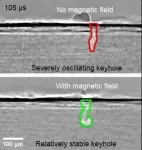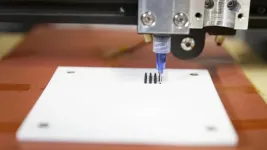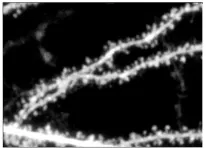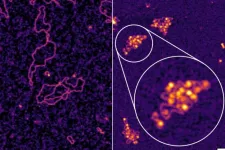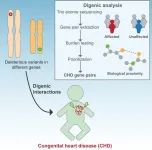(Press-News.org) Researchers have reported a method for breaking down commercial polymers like Plexiglass into monomers, a form more desirable for reuse. This could help alleviate the growing plastic waste stream. Most current plastic recycling methods rely on macroscopic mechanical shredding, cleaning and reprocessing. As a result, the properties degrade relative to the virgin polymer. Chemical decomposition to the original monomer would enable more thorough purification and then repolymerization to restore ideal performance. Here, Hyun Suk Wang and colleagues report the discovery that in dichlorobenzene solvent, violet light irradiation can cleanly break down polymethacrylates such as Plexiglass to their original monomers. The process appears to involve hydrogen abstraction from the backbone by small quantities of chlorine radicals liberated from the solvent. “The possibility to perform multigram-scale depolymerizations and confer temporal control renders this methodology a versatile and general route to recycling,” say the authors.
END
A new approach for breaking plastic waste down to monomers
Summary author: Meagan Phelan
2025-02-20
ELSE PRESS RELEASES FROM THIS DATE:
High-performance computing at a crossroads
2025-02-20
High-performance computing (HPC) systems – advanced computing ensembles that harness deliver massive processing power – are used for a range of applications, and the demand for them has increased with the rise of generative artificial intelligence (AI). However, for both traditional uses and to advance the power of AI, technical advances in HPC are greatly needed, say Ewa Deelman and colleagues in a Policy Forum. “With international competition for leadership in computing intensifying, without a renewed commitment, ...
Chemists find greener path to making key industrial chemical
2025-02-20
Scientists have discovered a potentially greener way to produce a crucial industrial chemical used to make many everyday products from plastics and textiles to antifreeze and disinfectants, according to a new study published in Science and co-authored by Tulane University chemical engineer Matthew Montemore.
The breakthrough could significantly reduce greenhouse gas emissions from the manufacture of ethylene oxide, which has an estimated $40 billion global market. The current production process requires chlorine, which is toxic and ...
Giant X-ray facility shows that magnets can reduce flaws in 3D printed components
2025-02-20
Safety critical components for aircraft and Formula 1 racing cars could one day be 3D printed via a new technique, developed by researchers at UCL and the University of Greenwich, that substantially reduces imperfections in the manufacturing process.
The technique was developed after the team used advanced X-ray imaging to observe the causes of imperfections that formed in complex 3D printed metal alloy components. If this technique becomes widely deployed it could make a range of these components, from artificial hip joints to aircraft parts, stronger and more durable.
The study, published in Science, observes the forces at play during ...
Cooling materials – Out of the 3D printer
2025-02-20
Rapid, localized heat management is essential for electronic devices and could have applications ranging from wearable materials to burn treatment. While so-called thermoelectric materials convert temperature differences to electrical voltage and vice versa, their efficiency is often limited, and their production is costly and wasteful. In a new paper published in Science, researchers from the Institute of Science and Technology Austria (ISTA) used a 3D printing technique to fabricate high-performance thermoelectric materials, reducing production costs significantly.
Thermoelectric coolers, also called solid-state ...
New knowledge portal adiposetissue.org enhances obesity and metabolism research with centralized data
2025-02-20
Addressing the Challenge of Dispersed Data
For years, adipose tissue research has generated vast amounts of omics data, but these datasets remained scattered across different repositories, making comprehensive analysis challenging. Adiposetissue.org now brings insights together, integrating transcriptomic and proteomic with clinical data from more than 6,000 individuals, enabling researchers to explore obesity-related changes, weight-loss effects, and cellular mechanisms with unprecedented depth.
“We developed ...
Study suggests new molecular strategy for treating fragile X syndrome
2025-02-20
Building on more than two decades of research, a study by MIT neuroscientists at The Picower Institute for Learning and Memory reports a new way to treat pathology and symptoms of fragile X syndrome, the most common genetically-caused autism spectrum disorder. The team showed that augmenting a novel type of neurotransmitter signaling reduced hallmarks of fragile X in mouse models of the disorder.
The new approach described in Cell Reports works by targeting a specific molecular subunit of “NMDA” receptors that they discovered plays a key role in how neurons synthesize ...
Digging into a decades-old hepatitis B mystery suggests a new potential treatment
2025-02-20
In their effort to answer a decades-old biological question about how the hepatitis B virus (HBV) is able to establish infection of liver cells, research led by Memorial Sloan Kettering Cancer Center (MSK), Weill Cornell Medicine, and The Rockefeller University identified a vulnerability that opens the door to new treatments.
The team successfully disrupted the virus’s ability to infect human liver cells in the laboratory using a compound already in clinical trials against cancer — laying the ...
Big birds like emus are technical innovators, according to University of Bristol researchers
2025-02-20
Large birds – our closest relations to dinosaurs - are capable of technical innovation, by solving a physical task to gain access to food.
This is the first time scientists have been able to show that palaeognath birds such as emus and rheas can solve tricky problems.
In the study, published today in Scientific Reports, emus, which have previously been called the ‘world’s dumbest bird’ were able to create one new technique to access food (lining up a hole with a food chamber) and moved the hole in the most efficient direction towards food in 90% of cases. A male rhea ...
Hidden genetic causes of congenital heart disease identified
2025-02-20
New York, NY [February 20, 2025]—Scientists at the Icahn School of Medicine at Mount Sinai and collaborators have identified novel genetic interactions that may contribute to congenital heart disease (CHD), a common birth defect. Details on their findings were reported in the February 20 online issue of The American Journal of Human Genetics [DOI: 10.1016/j.ajhg.2025.01.024].
“Our research reveals the potential for digenic inheritance—where two genes work together to cause disease—expanding our understanding of the genetic underpinnings of congenital heart ...
Semaglutide and nonarteritic anterior ischemic optic neuropathy
2025-02-20
About The Study: The results of this study suggest a modest increase in the risk of nonarteritic anterior ischemic optic neuropathy among individuals with type 2 diabetes associated with semaglutide use, smaller than that previously reported, and warranting further investigation into the clinical implications of this association.
Corresponding Author: To contact the corresponding author, Cindy X. Cai, MD, MS, email ccai6@jhmi.edu.
To access the embargoed study: Visit our For The Media website at this link https://media.jamanetwork.com/
(doi:10.1001/jamaophthalmol.2024.6555)
Editor’s ...
LAST 30 PRESS RELEASES:
Post-stroke injection protects the brain in preclinical study
Cardiovascular risk score predicts multiple eye diseases
Health: estimated one in ten British adults used or interested in GLP-1 medications for weight loss
Exercise to treat depression yields similar results to therapy
Whooping cough vaccination for pregnant women strengthens babies’ immune system
Dramatic decline in new cases of orphanhood in Uganda driven by HIV treatment and prevention programs
Stopping weight loss drugs linked to weight regain and reversal of heart health markers
Higher intake of food preservatives linked to increased cancer risk
Mass General Brigham–developed cholera vaccine completes phase 1 trial
First experimental validation of a “150-year-old chemical common sense” direct visualization of the molecular structural changes in the ultrafast anthracene [4+4] photocycloaddition reaction
Lack of support for people on weight loss drugs leaves them vulnerable to nutritional deficiencies, say experts
Dogs’ dinners can have greater climate impact than owners’
Are you ready to swap salmon for sprats and sardines?
1.6 million UK adults used weight loss drugs in past year
American College of Cardiology comments on new dietary guidelines for Americans
American Society of Gene & Cell Therapy and Orphan Therapeutics Accelerator partner to advance and commercialize promising rare disease treatments
One in 14 patients having day case surgery have new or worse chronic pain 3 months after their operation
New study highlights link between eviction rates and gun violence
Heatwaves heat up soil but not toxin levels in rice, study finds
Digital modeling reveals where construction carbon emissions really come from
Turning farm waste into water filters
New study shows how the spleen helps the immune system accept a transplant
New Mayo Clinic study advances personalized prostate cancer education with an EHR-integrated AI agent
Researchers identify novel therapeutic target to improve recovery after nerve injury
Microbes in breast milk help populate infant gut microbiomes
Reprogramming immunity to rewrite the story of Type 1 diabetes
New tool narrows the search for ideal material structures
Artificial saliva containing sugarcane protein helps protect the teeth of patients with head and neck cancer
Understanding the role of linear ubiquitination in T-tubule biogenesis
Researchers identify urban atmosphere as primary reservoir of microplastics
[Press-News.org] A new approach for breaking plastic waste down to monomersSummary author: Meagan Phelan
